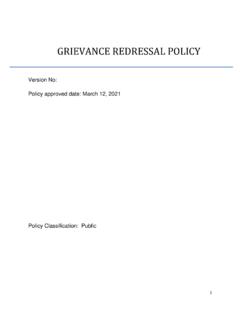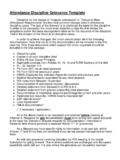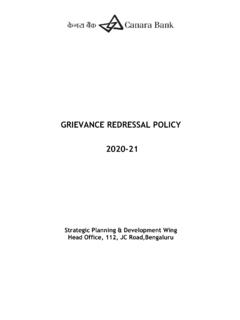Transcription of Designing and Implementing Grievance Redress Mechanisms: …
1 A Guide for Implementors of Transport Projects in Sri LankaDESIGNING AND IMPLEMENTINGGRIEVANCE Redress MECHANISMS A Guide for Implementors of Transport Projects in Sri Lanka 2010 Asian Development Bank All rights reserved. Published 2010. Printed in the Philippines. ISBN 978-92-9092-019-9 Publication Stock No. RPT101892 Cataloging-In-Publication Data Asian Development Bank. Designing and Implementing Grievance Redress mechanisms: a guide for implementors of transport projects in Sri Lanka. Mandaluyong City, Philippines: Asian Development Bank, 2010. 1. Grievance Redress mechanisms. 2. Road Development Authority. 3. Road projects. 4. Southern Transport Development Project. 5. Sri Lanka. I. Asian Development Bank. The views expressed in this book are those of the authors and do not necessarily reflect the views and policies of the Asian Development Bank (ADB) or its Board of Governors or the governments they represent. ADB does not guarantee the accuracy of the data included in this publication and accepts no responsibility for any consequence of their use.
2 By making any designation of or reference to a particular territory or geographic area, or by using the term "country" in this document, ADB does not intend to make any judgments as to the legal or other status of any territory or area. ADB encourages printing or copying information exclusively for personal and noncommercial use with proper acknowledgment of ADB. Users are restricted from reselling, redistributing, or creating derivative works for commercial purposes without the express, written consent of ADB. Asian Development Bank 6 ADB Avenue, Mandaluyong City 1550 Metro Manila, Philippines Tel +63 2 632 4444 Fax +63 2 636 2444 For orders, please contact: Department of External Relations Fax +63 2 636 2648 CONTENTS ABBREVIATIONS ii FOREWORD iii PREFACE iv I. SITUATING A Grievance Redress MECHANISM 1 A. What Is a Grievance Redress Mechanism? 1 B. Why Does a Project Need a Grievance Redress Mechanism? 2 C. Policy Requirements for Establishing a Grievance Redress Mechanism 3 D.
3 Grievance Prevention 5 II. Designing A Grievance Redress MECHANISM 7 A. Set Goals, Objectives, and Scope 7 B. Anticipate Types of Grievances 7 C. Provide Structure 8 D. Establish Procedures and Time Frames 11 E. Appoint Members 11 F. Provide Resources 11 III. Implementing A Grievance Redress MECHANISM 12 A. Set Up Institutions 12 1. Grievance Redress Committees 12 2. Special Mediation Boards 16 3. Land Acquisition and Resettlement Committees and Super LARC 16 4. Recent Developments in Payment for Land Acquired for Development 17 5. A Mechanism to Manage Construction-Related Complaints 18 B. Build Capacity A Precondition for Implementation 19 C. Create Awareness 21 D. Implementing Steps 21 1. Assign Focal Points 22 2.
4 Receive and Register Complaints 22 3. Screen and Refer the Complaints 23 4. Coordinate with Other GRMs 23 5. Assess the Complaint 24 6. Formulate a Response 24 7. Select a Resolution Approach 25 8. Implement the Approach 25 9. Settle the Issues 26 10. Track, Document, and Evaluate the Process and Results 27 ANNEXES 1. Roles and Responsibilities of the Central Environmental Authority 29 2. Urban Development Authority Guidelines and Land Use Maps 30 3. Steps in Land Acquisition 32 4. Accelerated Land Acquisition Process Based on Experience with Road Projects 36 5. Compensation Entitlement Matrix as per Regulations Enacted by Parliament 37 on 17 March 2009 6. Public Complaints Resolving and Monitoring Committee 40 7. Sample List of Public Complaints 43 8. Sample Graph Monitoring Status of Construction-Related Complaint Assessments 45 9. Building Capacity for Grievance Redress Mechanisms 46 10.
5 Proposed Grievance Redress Registering and Monitoring Form 53 11. Format for Recording the Proceedings of Grievance Redress Committees 55 12. Format for Recording Compensation Entitlements under the Land Acquisition and Resettlement Committee 56 13. Format for Certification of Compensation Entitlements under Land Acquisition Act and Land Acquisition and Resettlement Committee 58 ABBREVIATIONS ADB Asian Development Bank AP affected parties/persons CBO community-based organization CEA Central Environmental Authority CSO civil society organization DS divisional secretariat EMP environmental management plan ESD Environment and Social Division GRC Grievance Redress Committee GRM Grievance Redress mechanism GSMB Geological Survey and Mines Bureau IOL inventory of losses IPSA initial poverty and social assessment LAA Land Acquisition Act LARC land acquisition and resettlement committee MOH Ministry of Highways NGO nongovernment
6 Organization NWSDB National Water Supply and Drainage Board PCRMC Public Complaints Resolving and Monitoring Committee PMU project management unit RA resettlement assistant RDA Road Development Authority RO resettlement officer SIMO social impact monitoring officer STDP Southern Transport Development Project TA technical assistance TRI Tea Research Institute UDA Urban Development Authority FOREWORD Development projects of different scales are carried out by countries with the ultimate goal of enhancing their socioeconomic and environmental conditions and the overall well-being of their populations. However, such projects do not always engender positive changes in the lives of all the people intended to benefit from them. They can place some people at high risk and in adverse situations such as losing their dwellings, property, livelihoods, common resources, social relationships and organizations, cultural practices, and security.
7 Population displacements can critically affect the lives of vulnerable and high-risk groups like women and female-headed households, elderly and differently abled persons, people with chronic illnesses, and children. But many adverse conditions due to large-scale development projects can be either completely avoided or minimized. Displaced and resettled communities can be provided with adequate assistance in the form of cash and/or material compensation to improve their living conditions. Redressing grievances of affected people should be an integral part of a project s design, plan, and management. Setting up appropriate mechanisms to address community concerns, prevent adverse consequences and risks, and bring about positive changes in people s lives and relationships is increasingly important in development projects. Resolving grievances of project-affected people at the lowest level, without allowing them to escalate into unmanageable levels, equally benefits both the aggrieved parties and the project implementors.
8 This Guide, based on accumulated experiences of the Southern Transport Development Project, offers a range of options for Grievance resolution and provides a comprehensive set of guidelines, tips, methodologies, and tools for Designing and Implementing Grievance Redress mechanisms for road sector development projects. However, projects should be cautious not to allow affected people to "shop around" Grievance Redress mechanisms and to abuse them for their private agendas. Grievance Redress mechanisms should exercise their rights and functions with great accountability, transparency, and empathy toward affected parties. Effective communication and coordination among different Grievance mechanisms are also important. I congratulate the Office of the Special Project Facilitator (OSPF) and the South Asia Department, particularly the Sri Lanka Resident Mission, of the Asian Development Bank for the initiative taken to develop and present this Guide, which no doubt will be a useful reference for the designers, planners, and implementors of road development projects.
9 PREFACEP eople affected by development projects should be provided with access to mechanisms that are legitimate, reliable, transparent, and cost-effective to enable them to present their grievances and find solutions that satisfy their needs and aspirations. This Guide presents a set of guidelines for Designing and Implementing Grievance Redress mechanisms (GRMs) that can address a variety of grievances arising from road projects. GRMs can also enable projects to clarify misperceptions or resolve confusion among various stakeholders. The guidelines suggested herein evolved through experiences accumulated in the Southern Transport Development Project (STDP, also called the Colombo-Matara Express Highway) jointly funded by the Asian Development Bank (ADB) and the Japan Bank for International Cooperation (JBIC). Information included in this Guide was derived from a number of sources.
10 The Centre for Poverty Analysis (CEPA) reviewed STDP GRMs, and the findings served as a basis for the development of the Guide. This review included key informant interviews and focus group discussions. Since CEPA is also the independent external monitor of the STDP, it extracted information on Grievance handling from its large database of household interviews. A workshop that validated the CEPA findings provided additional useful information. In addition, documents from the STDP head office in Colombo and its regional offices in Galle, Dodangoda, and Bandaragama were reviewed. This Guide also incorporates information derived from interviews conducted with a number of STDP officers at the head office and in the regional offices as well as additional interviews with a small number of affected persons. The draft Guide was reviewed in a workshop on 30 October 2009, and comments were incorporated into the final version.

















